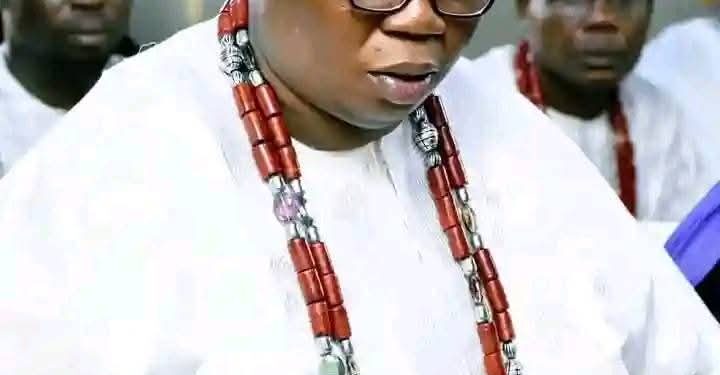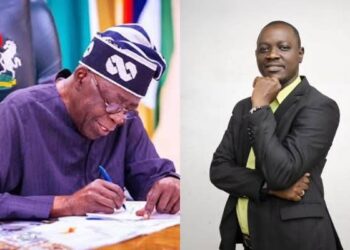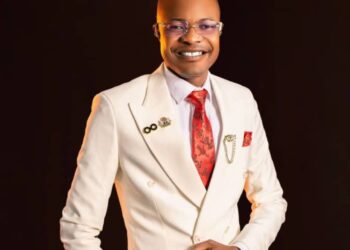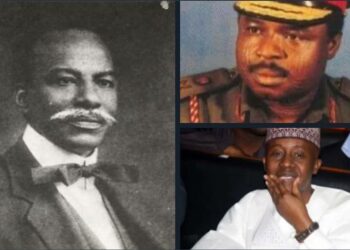By: Mógàjí Gbóyèga Adéjùmò
The Gbònkà Ààre Ona – Kakanfò of Yorubalnd

The Ààrẹ Ọ̀nà Kakaǹfò of Yorubaland — Critical analysis of the origin, role and placement of the office of the Yorùbá Generalissimo.
Wednesday, April 30, 2025
Ààre!
Ààre!
Orí mi, má jẹ́ n ṣ’Ààre Ònà Kakanfò.
Ààre!
Ọlọ́run, má jẹ́ n ṣ’Ààre Ònà Kakanfò.
Ààre!
Ààre!
Ààre!
Translation:
Ààre!
Ààre!
My head (being), don’t let me offend The Ààre Ònà Kakanfò.,
Ààre!
God, don’t let me offend The Generalissimo!
Ààre!
Ààre!
Ààre!
It so happened that a woman of Ìwéré-Ilé was to have written herself and the sleepy town embedded in the hilly corridor of the òkè-ògùn Axis into history when she gave birth to an Ọ̀yọ́ prince, Ajagbo mò gún ùn létí á lé ẹlẹ́mẹlẹ at some point during the many wars between Ọ̀yọ́ and the Ìbàrìbá…
History puts this period squarely around the 15th and the 16th centuries..
Àjàgbó the young prince emerged from the the spate of wars and dislocation that set Ọ̀yọ́-ilé back for a period of 100 years…
Not until Aláàfin Ọ̀rọ̀mpọ̀tọ̀, followed by Abipa, Obalokun, Oluodo had done their glorious beats by relocating from Ọ̀yọ́-Ìgbòho to Ọ̀yọ́-ilé, even from Borguland, where The Aláàfin had had to seek refuge at some point…. but somebody else to consolidate on the huge feat of going back to Ọ̀yọ́-ilé in the heart of the clear danger of nearness and exposure to Nupe and Ìbàrìbá raids and wars..
Aláàfin Oluodo had died in the final war with the Nupe and the Grandson of Aláàfin Obalokun,
Àjàgbó became the Aláàfin who ensured the political and war strategies to make sure Ọ̀yọ́ became better defended, better administered and better organized to withstand future aggression.
The significance of Ìwéré-Ilé, The Ìwàrẹ̀fà and the Ọ̀yọ́-Mèsì in the origin of The Kakaǹfò, is yet another topic that will have to be addressed at some point in future, suffice to say The Ìwàrẹ̀fà, custodians of wisdom, a very influential group in the Yorùbá traditional institution, made it possible for a series of consultation to be used in defining the process that led to the creation of Four administrative divisions under the Aláàfin that covered almost all the land space occupied by the Yorùbá as at the time.
It is worthy of note that The Ọyọ first established contact with the Europeans at the coast during the reign of Alafin Ọbalokun, in the first half of the 16th century…
Aláàfin Àjàgbó it was, around the period starting from 1530 to 1560, who took the bold step in protecting the Yorùbá realm by endorsing the creation of the “Ẹkùn mẹ́rin”, The four administrative divisions of Ẹkùn-ọ̀tún, Ẹkùn-òsì, Ẹkùn-ebolo and Ẹkùn-epo…. This important administrative process completed, the next natural step was to find the right kind of process to drive this through.
Aláàfin Àjàgbó, made a strategic and profound decision to appoint a Generalissimo as head of the security architecture to protect the Yorùbá empire of Ọ̀yọ́ from further and future aggression and aggressors.
In kòkòrò Gangàn, he found such a man of steel, of Valor of Courage, of bravery.
And the very first assignment of Kakaǹfò Kòkòrò Gangàn was the annexation of the Ègùn state of Wemẹ and successfully too.
Thereafter The Kakaǹfò institution has come to be central, integral to the Yoruba Ọ̀yọ́ empire, its growth and sadly too, its decline.
The rich culture of the Yoruba will once again begin to unfold from the 15th to The 16th of January 2020, as the Ààrẹ Ọ̀nà Kakaǹfò Iba Gani Adams, marks his 2nd year in office, as the Supreme Head of the security architecture of the Yorùbá nation.
As it was with Ààrẹ Kòkòrò Gangàn and 14 others after him, an Ààrẹ is crowned, coronated with certain ensigns and insignia of office that remain till today, an exclusive preserve of the Ààrẹ.
On the head of the Ààrẹ sits the “Ojijiko” crown, a unique coronet that is truly crown shaped, fitted with the oxblood feathers of the parrot’s tail, the leopard skins he wears like an apron and sits on too and his unique staff upon which he becomes the head of all the Yoruba warriors…. It is only the next natural step for the Ààrẹ to appoint his Chiefs along the lines of the old order.
Traditionally, The Aláàfin, with the support of his Ọ̀yọ́-Mèsì chiefs-in-council, reserves the right to select a warrior to become Ààre Ọ̀nà Kakaǹfò… And such a pattern subsists till this day.
As the Ààrẹ is above every other warrior, he is Iba, a title of rulership that is akin to a king, with even the powers to depose a recalcitrant king often so demonstrated in the past.
On installation, the Ààrẹ begins his reign by appointing his own chiefs….
Sixteen of such chiefs are the principal chiefs with 54 others to make up the 70 Ẹ̀sọ́, thus were they, the elite warriors of old made!
It is significant to note that Tóyèjẹ́ the Șọ̀ún of Ogbomoso became the Ààrẹ Ọ̀nà Kakaǹfò after the death of Àfọ̀njá, while Òjó Aburúmákùú, yet another Șọ̀ún became The Ààrẹ from the throne with Asúbíaró Látóòsà of Ìbàdàn as his Ọ̀tún Ààrẹ taking over as the substantive Ààrẹ after him, while Ògúnmọ́lá also of Ìbàdàn was Òsì to Iba Ààrẹ Ikúrunmí of ìjàyè…
During the time of Àfọ̀njá, a significant thing also happened. A chief of Ìwéré-Ilé, Ọpẹlẹ, held the title of Òsì Kakaǹfò, the commander of the left wing under the Ààrẹ Ọ̀nà Kakaǹfò… Aláàfin Aólẹ̀ had earlier ordered Àfọ̀njá to sack the town that Àjàgbó had forbidden to be attacked, instead, Àfọ̀njá made an Òsì out of the whole matter.
Likewise, Ìbítòlá Òkú of Jàbàtá, Ò-kú-láárọ̀-jí-lálẹ́, was the Baálẹ̀ of the small sleepy Jàbàtá town, near Ogbomoso that produced The Ààrẹ who brought not only fame to the town but the crown upon which an Ọba now holds office as different from a lowly Baálẹ̀, just because an Ààrẹ emerged from there….
Such is the nature of The Ààrẹ, that even kings of old sought to be made the Generalissimo!
Ààrẹ Òkú was the son of Adéta Lángbin, also a former Kakaǹfò.
He continued the war his father fought and died in Jàbàtà, a peaceful death.
Contrary to the myth that an Ààrẹ is prone to a violent end, no less than five Ààrẹs died peacefully… Òjó Aburúmákùú, Òkú, Abemo among those who lived to particularly into the ripeness of their ages before succumbing to their natural deaths..
Of all the Kakaǹfòs, Àfònjà of Ìlorin was the only one remotely related to Ọ̀yọ́ royalty, as he was maternally a prince of Ọ̀yọ́. All others were not of that nature either Indigenes or residents of Ọ̀yọ́ as stipulated in the ordinance of the institution of the Ààrẹ handed down by Àlàáfín Àjàgbó.
Perhaps that may also be the reason behind Àfọ̀njá’s Treachery against his Sovereign, The Aláàfin that has become the nemesis of Ilorin being ceded to the Fulani.
Aláàfin Àjàgbó expressly commaned three injunctions that — The Kakaǹfò must never attack Ìwéré-Ilé, his mother’s hometown — The Kakaǹfò must never attack Ilé-Ifẹ̀, the origin of the Yorùbá and lastly that the Kakaǹfò must neither be Nobility of Ọ̀yọ́ or a resident of the City.
Àfọ̀njá’s candidacy failed in the critical aspect of being nobility and royalty.
One may indeed be forced to enquire as the reasons why The Ààrẹ’s predecessors of SLA Akintola and MKO Abiola did not seem to have appointed their own Chiefs…
The answer is simply this:
When Chief SLA Akintola became Kakaǹfò in August of 1964, it was at a time of a huge political dynamics, in which Akintola as premier was more involved in governance and political survival than in tradition.
Regarding Chief MKO Abiola’s case, his refusal to carry out the full coronation rites due to his strong Islamic leanings prevented a continuation of a tradition that is over 500 years old.
For instance, the Ààrẹ Gani Adams did all the full traditional rites of passage, including the 201 incisions, “gbẹ́rẹ́”, on his head and went through all the rituals progressively, from the Shango shrine, after having done similar initiations at Obatala’s shrine, Ogun’s shrine, Èṣù’s shrine and in conversation with The Earth Mothers of the Bird fraternity.. Awon Iyami Osoronga, among other rites …!
The rites of installation and coronation that Ààrẹ Gani Adams passed through to become the Kakanfo, should be considered as deep, perhaps more intense than what some major Obas go through to becoming kings..
An Ààrẹ, especially The Kakanfo, is a king in his own right.
The Ààrẹ of old did the same, everywhere.
Lest we forget, this present Ààrẹ is of the mold of the Ààrẹs of old… He is Not the Akintola or Abiola type Ààrẹ, but an Ààrẹ of the Yoruba, akin to the type we had in times of certain conditions of insecurity to the Yorùbá Nation.
It is therefore a strategic decision to address a particular need to have war time Chiefs, to further help in protecting the Realm from the incursion of the “Usual suspects”, into our land…!
Lest we also forget, during the time of Aláàfin Ajaka, to Eguguoju, Abiipa, Oluaso, up to the time of Aláàfin Jeayinfa, the Ìbàrìbá armies worried the Yoruba greatly and the Aláàfin had to seek the assistance of Ajagun-ńlá of Ìlá-ọ̀ràngún tó lead the Yoruba armies and Ajagun-ńlá appointed Onikoyi, Olugbon and Aresa as his own Chiefs, who are today important Kings in Yorubaland, that was around the year 1430.
Therefore, when Aláàfin Ajagbo installed Kòkòrò gangàn of Ìwòye as the first Ààrẹ, majorly to check the incessant attacks of the Ìbàrìbá, the Ààrẹ also in the continuation of the process of defending the realm!
Whilst the Cabinet Chiefs, the Bashorun as the Prime minister, the Shaamu, Alapinni, Kudefu, Laguna, Akiniku, are Chiefs by their rights to generational lines, the Chiefs of the Kakanfo are not. Like the Ààrẹ, they are chosen by the very process of their Valor and bravery…. By their loyalty to defending the Yoruba space as by being a True Ẹ̀ṣọ́, the Brave. A reward of merit only, not social standing, qualifies one to be made a chief of the Kakanfo.
Traditionally, Ààre Ònà Kakanfò’s appearance is distinct among the Ẹ̀ṣọ́ because of his
paraphernalia of office and dress codes. His unique dressing and other insignia of office place him on the highest level of command. After the installation, Ààré Ònà Kakaǹfò keeps the routine of shaving the hair on his head, leaving “ààsó”, hair tuft, on the head, wearing an “Ìbàntẹ́” made of a leopard skin, sitting on a leopard skin,
wearing a long kingly crown “Ojijiko” made of the parrot’s red feathers, and carrying with him “ọ̀pá
ìségún”, òdùro, which means “the weapon of victory.”
It is only this weapon that he carries
to any war, not gun. Also, he ties charms round his body and wraps his body up with magical clothes when he is in the house.
The leopard skin is a common dress
feature of Ààre Ònà Kakanfò. Samuel John writes that Kakanfò wears coronet, “Akòro”, the type The ọbas wear, as his head must always be covered when not with6his crown.
Keeping strictly to this tradition extended to Aare Ona kakanfò Látòsísà, the last of the old-
era, Ààré Ònà Kakanfò Iba Gani Adams has his signature Abetí-ajá hat on, always….It is hoped that as he celebrates his 8th year anniversary, his crown will once again be brought out to place him among the Yorubas their Generalissimo and the “Akòro” headgear that is befitting goes with his dressing also.
Duties of Ààre Ònà Kakanfò:
The Kakanfo’s duty is scary, not many people would want to do it. That the individual Ààre
Ònà Kakanfò stands up to the task relating to his office, in spite of difficulty, makes him a hero. His major duty is presented as follows in the words purported to have been given to the very first Ààrẹ as retold by the Ọ̀yọ́ palace custodians:
“Ètò Ààrẹ ni láti rí sí ídáàbòbò gbogbo ilẹ̀ Yorùbá; ètò rẹ̀ ni láti bi ogun t’ó bá wà làti ìta wó; ètò rẹ̀ náà sì ni láti gbógun lọ ilẹ̀ mìíràn fún ìkógun àti fún fífẹ ilẹ̀ Yorùbá sẹ́hìn si i…
Òun ni ó máa ń pín ìkógun fún ọba àti àwọn ìjòyè àti àwọn Balógun abẹ́ rẹ”
Meaning:
It is Ààrẹ’s responsibility to defend the entire Yoruba land; it is his duty to defeat external attacks; also, it is his duty to attack other places, to conquer them, and to expand the
Yoruba territory. He is the person to distribute war booties to the king, to the chiefs, and
to all commanders under him.
Thus we find the Ààrẹ Oyalabi defending the Yorùbá Ọba Oninana of the Ga people in far away present Ghana at the command of the Aláàfin at the time of Aláàfin Agboluaje Labisi and Aláàfin Awọ́nbíojú!
The significant role of The Kakaǹfò in the expansion and defence of motherland must be clearly understood…
The more pushed out narrative also of an Ààrẹ causing the decline as we saw in the case of Àfọ̀njá Láyalókò who rebeled rather than rally to his Sovereign, and fought against the realm will have to be processed at yet another opportuned time.
We therefore must remember great moments in which The Ààrẹ fought wars to secure not only peace and security, but also to secure land and prosperity for the empire.
We remember Ààrẹ Kòkòrò Gangàn, Ọ̀yálàbi, Adẹtà, Oku, Tóyejẹ̀, MKO Abiola, for all their Great Sacrifices…
We remember Ààrẹ Kòkòrò Gangàn for expanding the realm into the Ẹ̀gbádo-Ègùn corridor, Ọ̀yálàbi for his exploits stretching the empire from Rivers Niger to The Volta, Adẹtà, for quelling the Basọ́run Gaa constitutional breech against the Sovereign, Oku for his many wars against the Fulani, Tóyejẹ̀ the great Kakaǹfò from Ogbomoso upon whose exploits the inspiration came for the Ogbomoso anthem — Ogun ò jà ó jà, tí ó fi kó Ogbomoso!
Ààrẹ Tóyejẹ̀ sacrificed two of his children as part of his efforts in making sure the Fulani never got a, foothold into the heartland of Yorùbáland…. And if anyone would frown at this, remember, the man of Bethel in Israel who sacrificed his two sons to rebuild Jericho….. Suffice to say Jericho has remained the oldest inhabited city in the world!
We remember, Ààre MKO Abiola, who sacrificed himself for our hard fought democracy to our legacy…..
The exploits of our past and present Kakaǹfòs, we must never forget.
Traditionally, Ààre Ònà Kakanfò should obey the command of The Aláàfin and relate with other Ọbas for strategic decisions on yoruba issues… The Ààrẹ’s commission to engage the enemies of Yorùbáland also involve consultations with other Yorùbá notables wherever they may be found!
Kakaǹfò duty is to be in control of wars. Kakaǹfò uses the commanders under him to execute war plans, and he goes to the war front only when a war is too tense and difficult
to fight. His duties make his office and personality heroic, for not many people can face death
and discharge the kind of duties that go with the office of Aare Ona Kakaǹfò!
Binding on the Institution and on the Title Holders, are the following injunctions:
A number of restrictions are in place traditionally to regulate the Kakanfò institution and the
holders of the title. First, Ààre Ònà-Kakanfò is constrained customarily to be installed by the Àlàáfín of Ọ̀yọ́ in consultation with other notable Yorùbá obas, and, second, in a normal situation only one Kakaǹfò reigns at a time. Third, only a brave audacious man from any part of Yorùbáland can be made The Ààrẹ!
A common belief among the Yoruba is that Kakaǹfò is supernaturally powerful, that the rituals that accompany his installation constitute the source of his power, so Kakaǹfò is
always held in awe; people hardly want to cross his path.
A common Yorùbá song that
signals that people fear Kakanfò goes as follows:
Ààrẹ!
Ààrẹ!
Ààrẹ!
Orí mi, má jẹ́ n ṣẹ Ààrẹ Ònà Kakaǹfò.
Ààre!
Meaning:
Ààre!
Ààre!
Ààre!
My being, my inner head, don’t let me offend Ààrẹ Òna Kakanfò.
The Yorùbá believe that Kakaǹfò is unpredictable, that he could kick against anything- even
the choice determined through Ifá divination, so they always await his command.
That is why
the Yorùbá like saying, “Ààrẹ ń pè ọ́. Ò n dífá! Bífá bá fọre, bí Ààrẹ kò bá fọre ń kọ́?” — Ààre
sends for you, you are consulting Ifa oracle! What will happen when Ifa says a pleasant
message but Ààre’s response is unpleasant??
There lies the reverence given to The Ààrẹ!
Is the Title of Ààrẹ Ọ̀nà Kakaǹfò still Relevant Today?
The institution of the Aláàfin, the sole authority over the appointment of Kakanfò, is no
longer very powerful as it used to be before 1889 when the Àlàáfín signed a peace treaty with
other tribes and succumbed to the British system of government which took over the control of the Yorùbáland.
Because of the reduction in the power and land territory of the Àlàáfín today, the traditional Yoruba army is no longer really visible though some traditional military titles are still alive and the Aláàfin and other Ọbas do ceremoniously give them to those who deserve them.
This situation might make people say there is no longer a need to appoint Ààrẹ Ònà Kakanfò.
Also, the cloudy dust -violence or disturbance- that preceded the death of the last two
occupiers of the position – Samuel Ladoke Akintola and Moshood Kasimaawo Olawale
Abiola- and the nature of their death might also serve as justification for debunking this
traditional title. Ladoke was killed by the military junta during a coup d’etat while Abiola
died in captivity as the United Nations representatives to Nigeria were negotiating his release from the brutal military dictator, General Sanni Abacha.
However, since the institution of the Aláàfin has drastically changed and adjusted to
modernity, the institution of the Kakaǹfò should also be modernized and revived because of its significance in
the history of the Yoruba, and the challenge of modern politics poses in Nigeria, which seemingly has not truly favored the marginalized YORÙBÁ, particularly with the recent Infiltration into the Yorùbá space foreigners of the Fulani type and others causing serious security issues..
And the impact the title holder can make at these times is enormous as The Current Title Holder, Iba Gani Adams, an activist, a freedom fighter, has been very pivotal in keeping the infiltrators at bay and away from the Yorùbá space through his Oòduà People’s Congress, a Yorùbá Sociocultural group of about six million membership and through his Oòduà People’s Union that is a Yorùbá centric group established in 87 countries all over the world.
The Ààrẹ Ọ̀nà Kakaǹfò Iba Gani Adams, in 7 years after his installation, has become a unifying factor in the making of Sociocultural and political decisions that goes beyond the Yorùbáland in the context of other ethnic groups, as the right person bears
the title — Abiodun Ige Adams.
He has been able to pull the majority of the Nigerian
ethnic groups along together with the country’s Heads of Security agencies…!
He is instrumental to the Coalition of all security groups on Yorùbáland that is now a body ready to partner with the governments of the South-west Yorùbá states in the coming to be of “Àmòtẹ́kùn”, the Yorùbá regional security agency designed to help stem the recent spate of insecurity that is prevalent at these times..
The heroic aspect of the title is part of
the Yoruba concept of military and political heroism; therefore, the continuation of the
institution is imperative because of the modern challenges that require a competent hand to handle on behalf of the entire Yoruba engaging in the competitive, slippery “political path” of Nigeria!
Conclusion:
In spite of changes in the modern era and people’s fear about the institution, The Kakaǹfò Office, is an institutional heroic symbol of the past, and the present should take a good cue…
Power struggles among the Yorùbá, uncertainties about our political future, the sever insecurity issues all make it compelling for the Office of the Ààrẹ to be expanded, just as the present Ààrẹ is doing to involve many notable Yorùbá into his Cabinet.
As such, many more are to be drafted into his Council as part of his 2nd year coronation anniversary.
Those who value the tradition and history would want the tradition to be preserved for the present and
future generations.
However, the Yoruba should realize that they now co-exist with other peoples, so they should encourage their Kakaǹfò, to use dialogues, diplomacy and strategy in solving conflicts instead of
engaging in war….
Yet the question also subsist —
Can diplomacy alone, serve as the substitute weapon for Ààrẹ Ònà-Kakanfò of the
modern day…!??
History and tradition, as constructors of situations, events, and role players, will tell as time goes by…
You can get every of our news as soon as they drop on WhatsApp ...To get all news updates, Join our WhatsApp Group (Click Here)












